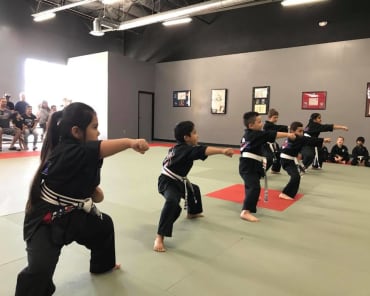
There are many titles of honor in the martial arts. These titles are given and earned above and beyond earning the coveted rank of black belt. In other words, just because you earn a black belt, does not mean you have earned the right to call yourself a Sensei or master. Each martial art depending on national origin (Japan, Korea, Thailand, China, Brazil or Philippines) have different but similar meanings to their martial arts titles.
The most commonly used tern that most people have heard is the Japanese term Sensei. The equivalent in Thailand for Muay Thai is Kru. Sabumnim in Taekwondo and other Korean arts. Guro in the Philippine martial arts. Sifu in Chinese styles and many Brazilian Jiu-Jitsu students call their teachers Professor.
For the ease I will use the term Sensei but you can easily translate to the above title to understand it from a different style perspective.
The term sensei includes several levels of meaning. Some martial artists equate it with "master", but this is a meaning that is not used much in our academy circles. As you advance in martial arts it becomes very apparent that there are so many techniques and aspects of training that it would take a lifetime to learn them all. Mastery seems to stay just out of reach, and it is not something that can easily be achieved or claimed. There are moments of mastery, like when a competitor achieves the elusive effortless strike or submission for a win, but they are fleeting. There is always more to learn, and martial arts teachers are usually the first to admit that they are more like beginners than masters.
 Most martial artists also consider a sensei to be a life-long guide who provides students with physical, mental and even sometimes spiritual training. In Japan it is quite appropriate to refer to a church leader or spiritual guide as a sensei. It is also appropriate to use the term for teachers in educational institutions, classical arts and crafts, temples, clubs and many other student-teacher relationships. While a martial arts sensei must know the techniques of their art, there is more that can be learned in classes besides physical skills. The lessons learned in training certainly can be applied to all aspects of life. Over three decades my teachers have shared their wisdom and understanding in many areas. This kind of relationship with a sensei though is quite rare. Students move, martial arts academies close, sensei retire, and it is hard to find an instructor that can provide you with such lessons for a long time.
Most martial artists also consider a sensei to be a life-long guide who provides students with physical, mental and even sometimes spiritual training. In Japan it is quite appropriate to refer to a church leader or spiritual guide as a sensei. It is also appropriate to use the term for teachers in educational institutions, classical arts and crafts, temples, clubs and many other student-teacher relationships. While a martial arts sensei must know the techniques of their art, there is more that can be learned in classes besides physical skills. The lessons learned in training certainly can be applied to all aspects of life. Over three decades my teachers have shared their wisdom and understanding in many areas. This kind of relationship with a sensei though is quite rare. Students move, martial arts academies close, sensei retire, and it is hard to find an instructor that can provide you with such lessons for a long time.
The Japanese word sensei literally means "one who has gone before". This is another way to look at the role of a sensei, and one that I especially identify with. In terms of a martial art, a sensei is the one with more experience who can guide you along the path. Although I am a teacher I competed extensively and knew what it was like to win and lose. Having demonstrated the required techniques to go through each of the ranks I was competent to help others along the same path. Having studied other martial arts I have an appreciation for the unique lessons of the arts. Being head coach of a large academy I saw a lot of students struggling to achieve their best. Having coached winning athletes I knew what it took to be successful. Sharing this knowledge and experience with others is what a sensei is all about. ![]()
What does [Renshi/Kyoshi/Hanshi/Shihan] mean?
In addition to the kyu/dan (underbelt/black belt) ranking system used by most Japanese martial arts, there is a parallel system called shogo (称号). The word loosely translates into English as title or rank. In this context, title is a bit more accurate. These titles are awarded only to dan (black belt) level martial artists – typically at high dan levels. Their primary purpose is to show that in addition to being a good martial artist, the individual is also a good teacher.
The shogo titles are independent of dan level and do not effect it. In other words, a promotion to one of these titles does not raise the practitioners dan level. However, there is a relationship between the two in that most organizations that use them impose minimum dan level requirements in order to earn the shogo titles. Earning the minimum rank is not enough. The teacher must also be nominated and approved for the title. Typically, they are awarded to teachers who have given something back to the organization he belongs to.
The three commonly used shogo titles are renshi, kyoshi, and hanshi. Some organizations will use the title shihan instead of hanshi. Other organizations will use the title shihan in addition to hanshi, independently of the formal shogo system. And because there are so many martial arts organizations, there are many different rules for receiving these titles. Yes, it can get a little confusing!

Renshi belt
Renshi (錬士)
Renshi literally means “polished teacher.” It is the first, or lowest, of the shogo titles. In many organizations this requires a minimum rank of godan (5th degree black belt), although others will award it at yondan (4th degree black belt). I even know of one organization that would award it at sandan (3rd degree black belt), although even within that organization this was not common.
A teacher awarded the title renshi is typically allowed to wear a belt that is half red, half white. The orientation of the belt depends on the organization. The American Budo Society, to which I belong, makes a distinction between renshi-sho (lesser polished teacher) and renshi-dai (greater polished teacher). A renshi-sho wears the belt white side up, while a renshi-dai wears the belt red side up. Most organizations make no such distinction, and typically the belt is worn red side up.

Kyoshi belt
Kyoshi (教士)
Kyoshi means “expert teacher,” although it is sometimes also translated as “professor” or “assistant professor.” Depending upon the organization, this typically requires a minimum rank of at least rokyudan (6th degree black belt) or shichidan(7th degree black belt).
Once awarded the title kyoshi, the teacher is entitled to wear a red and white paneled belt.
Hanshi (範士)
Hanshi translates literally as “exemplary teacher.” Many English speaking martial artists will use the term “professor” interchangeably with hanshi. This almost always requires a minimum rank of at least hachidan(8th degree black belt) and sometimes nanadan (9th degree black belt).
A teacher with the title hanshi is entitled to wear a solid red belt.
Shihan (師範)
Many martial artists speakers mistakenly assume (or are even taught) that shihan is a reversal of the same words that make up hanshi. To a non-Japanese speaker this sounds obvious. However, a quick look at the kanji shows that this is not the case at all. However, the difference in actual meaning is subtle. The shi (士) used in renshi, kyoshi, and hanshi translates more precisely into “gentleman,” “warrior,” or “scholar,” whereas the shi (師) used in shihan translates very directly into “teacher.” So one might say that shihan means “exemplary teacher” and hanshi actually means something closer to “exemplary gentleman.” However, since that’s not really how they’re used in English, both terms are often just used as a variation of “exemplary teacher.”
Some organizations use shihan instead of hanshi. Notably, the organizations that use shihan instead tend to be karate organizations, whereas judo, jujitsu and kendo organizations almost universally use hanshi instead. However, many organizations that use the shogo title of hanshi also use the title of shihan. However, in these cases its use is often far less formal and conferred by general usage rather than direct, proper “promotion.” Also in these cases, there are very few shihan in an organization (often only one).
Why isn’t my instructor wearing his [Renshi/Kyoshi/Hanshi] belt?
The etiquette of wearing the belts varies from organization to organization and sometimes from school to school within the same organization. In some organizations, once awarded, these belts are always worn. In others, they’re considered ceremonial belts and only worn on special occasions – seminars, reunions, and belt promotion ceremonies. In these cases, the practitioner typically wears a regular black belt striped as appropriate during normal classes.
Do these titles confer special privileges?
That depends entirely on the organization, but in many cases, yes, they confer special rights. In some organizations, instructors aren’t allowed to promote students to dan (black belt) ranks until they have specific shogo titles. In the American Budo Society, all black belts can promote up to two levels below themselves. The titles of renshi-sho, kyoshi-sho, and hanshi-sho allow promotion of up to one level below themselves, while renshi-dai, kyoshi-dai, and hanshi-dai allow promotion up to their own belt level. In other organizations, they confer no special rights at all.





